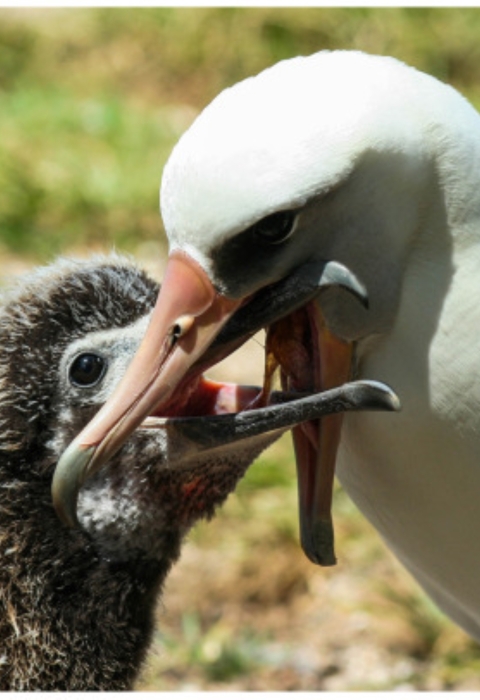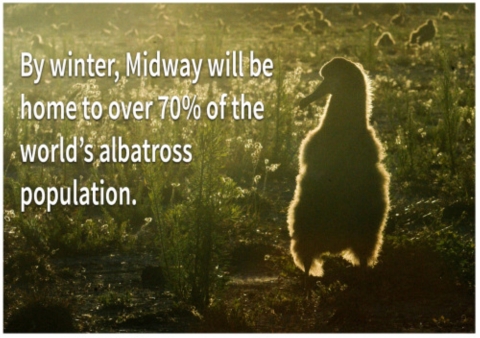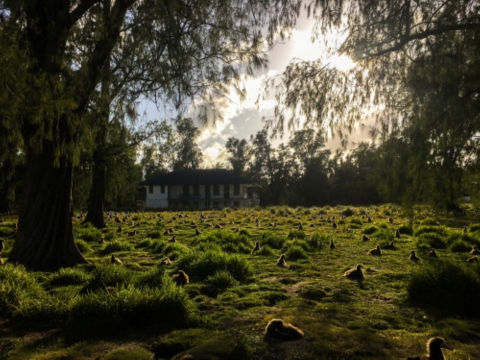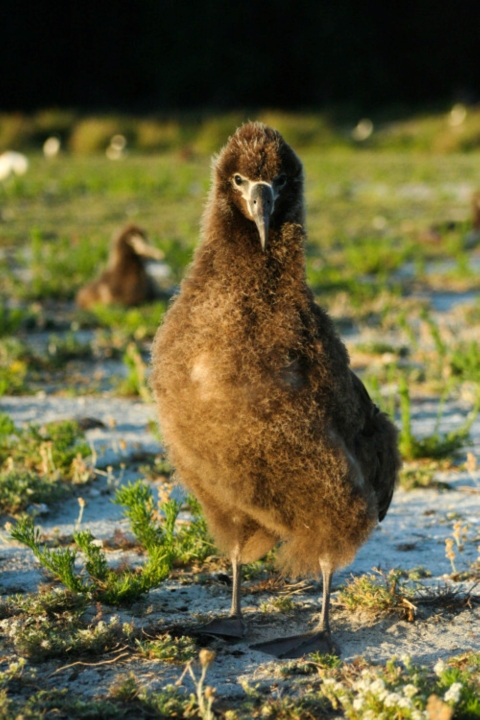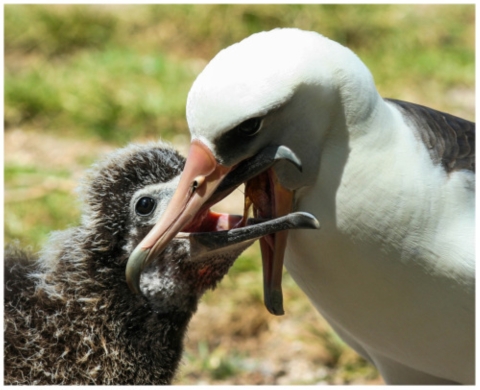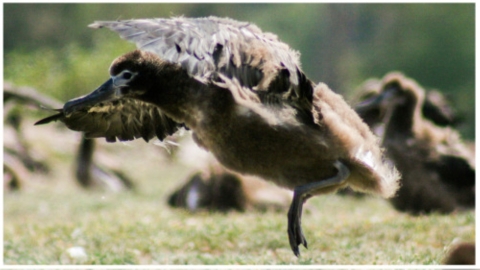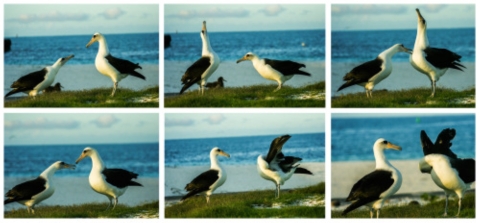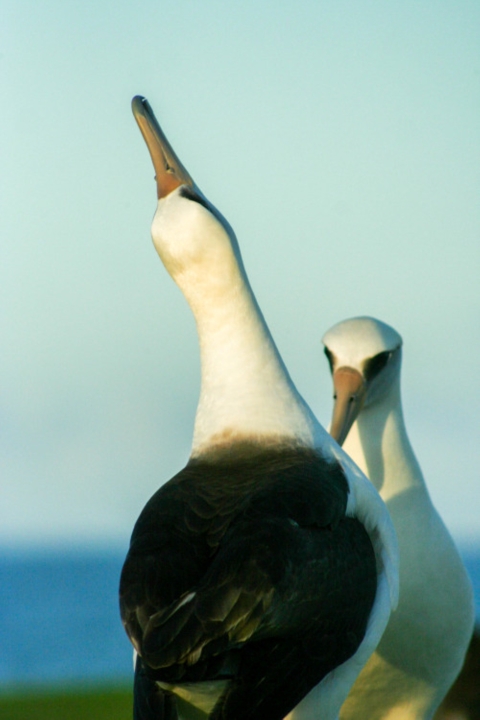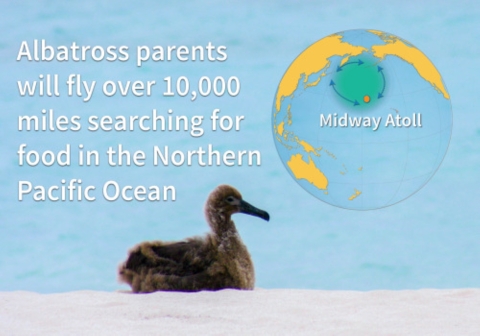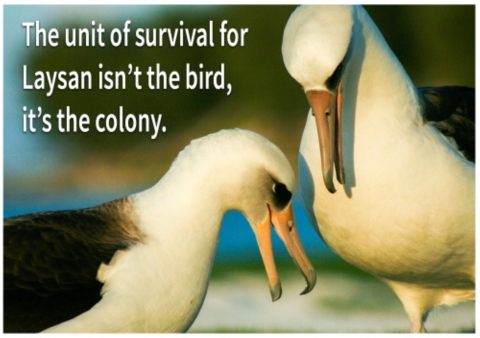This year is the 50th anniversary of the Endangered Species Act, a law that has been a powerful catalyst for conservation of America’s most treasured fish, wildlife, plants and their habitats. In the Pacific Region, our Tribes, state and federal agencies, and partners have joined with our dedicated staff to be the driving force behind the successes we share and the strength ensuring we can address the challenges ahead. Celebrate this milestone with us in this collection of stories as we reflect on past successes, assess current challenges, and envision an equally bright future for the next 50 years and beyond.
Over the next days and weeks after that first albatross arrives, the birds will come by ones and twos, then dozens, thousands, and eventually over one million Laysan Albatross will find their way back to these tiny pinpricks of land - less than 2 and a half square miles - in the vast expanse of the Pacific Ocean. By November the Laysans will have taken over the tiny island. Every square foot of land is occupied by a bird, and the air is full of the sound and the smell of them.
With life spans that rival many humans, the albatross life cycle mimics our own in many ways. Their longevity can actually be a challenge for the biologists who study them. The life span of a single bird can be two or three times that of the career of a researcher. Adding to the difficulty is the fact that Laysan Albatross spend 90% of their lives in the air and on the sea crisscrossing the North Pacific Ocean.
Most of what we can observe of their lives takes place in that narrow 10% of time that happens when the birds come to one of a few colonies in the Pacific to find a mate and fledge their chicks. There aren’t many places left for Laysan Albatross to nest, and Midway Atoll is by far the most important Laysan Albatross colony in the world.
Learn more about how scientists study Laysan Albatross on Midway
The First Year
Baby Albatross are clumsy adorable fluff balls, constantly looking for food from anyone or anything that passes by them. Their parents take turns foraging at sea to keep up with their chick’s voracious appetites and will fly extraordinary distances to find enough food.
They search for squid, fish eggs, fish, and other crustaceans near the surface of the ocean. Unfortunately, a lot of the food they collect - like fish eggs - comes attached to bits of plastic and floating marine debris. Back at the the albatross colony on Midway, the albatross parents regurgitate the forage for their chicks and end up feeding millions of pounds of plastic to their young every year.
“Adulting” is Hard
Laysan chicks fledge within six months of hatching and take to the open ocean. For the first years of their lives they grow and mature at sea and we know little of their activities during this time. Banded juvenile albatross will sometimes be seen visiting colonies far from where they were born. These early learning years are likely some of the most dangerous for the albatrosses.
Sometime between their third and fifth year, juvenile Laysan will return to their home colony during breeding season and begin the search for a mate - a process that can take years. Albatrosses are very selective in their choice of a mate, and with good reason. Raising a chick is a dangerous and difficult endeavor.
Both parents must incubate the egg and care for the chick during the first crucial weeks of life. But in order to find enough food for themselves and the growing chick, the albatross parents must fly thousands of miles to their foraging ground in the northern Pacific Ocean.
Groups of young albatross gather in twos and threes to practice courtship dances. They will spend several years learning the elaborate dances until they eventually find a mate. Laysan courtship dances can have dozens of ritualized movements that are distinct from other species of albatrosses..
To find a mate, juvenile albatrosses do what humans have been doing for thousands of years, they have dance parties.
They are looking for just that special bird to dip, bow, and preen with, and once a pair bond forms they stay bonded for life. It will take a pair bond another three or four years before they can successfully hatch their first chick.
The incredible about of time and work necessary for albatrosses to survive to adulthood, find a mate, and become a successful parent means that each adult pair bond is incredibly important to the overall survival of the colony. Albatrosses have been known to live and continue hatching chicks well into their sixties.
The oldest known wild bird in the world is a Laysan Albatross named Wisdom. In her 66 years she has raised as many as 36 chicks, and has clocked over six million miles of flying.
Raising the Next Generation
Once two albatross form a pair bond, they come back to their home colony nearly every year to mate and fledge a chick. The nesting process taxes and tests the limits of the pair’s endurance and health. Once an egg is laid, one of the parents will stay with it at all times through the two month incubation period and for the first weeks the chick’s life.
The female usually stays for a couple of days after laying the egg, then takes off to forage and regain her strength. Once she leaves, the male will sit on the egg for as long as three weeks at a time. Laysan albatross forage over expanses of open ocean that boggle the mind. They have been tracked foraging across an area over 4 million square miles in a single trip. That’s greater that the size of the continental United States!
All that waiting requires albatross to be incredibly patient and dedicated parents. Birds have been known to die from starvation and have event been eaten alive by predators while sitting on their egg waiting for their mate to return.
Birds have been known to die from starvation or predation waiting on their nest for their partner to return.
Midway Atoll has become the most important albatross colony in the world because of it’s size, safety, and the lack of continued human development.
For now, Laysan albatross have a safe and protected place to nest and fledge their chicks, and the overall population remains healthy and strong. But biologists worry about the future of a species that has become so reliant on a handful of tiny low-lying islands for their survival. What happens if Midway is lost to changing climates or invasive predators?
Biologists are working to establish new colonies of albatross on other Pacific islands as a hedge against rising sea levels, disease, or invasive predators because protecting the future for the Laysan mean protecting the places they call home.
###
The U.S. Fish and Wildlife Service works with others to conserve, protect, and enhance fish, wildlife, plants, and their habitats for the continuing benefit of the American people. For more information, visit www.fws.gov/pacificislands, or connect with us through any of these social media channels at https://www.facebook.com/PacificIslandsFWS, www.flickr.com/photos/usfwspacific/, https://medium.com/usfwspacificislands or www.twitter.com/USFWSPacific.
